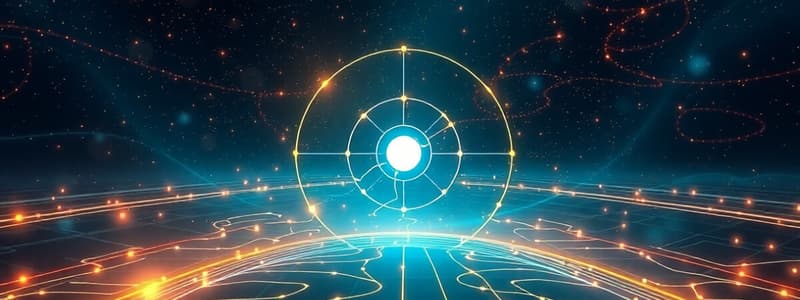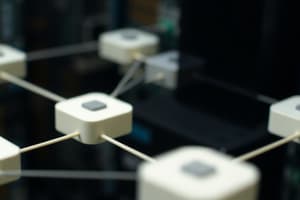Podcast
Questions and Answers
What is the primary purpose of the OSI model?
What is the primary purpose of the OSI model?
- To provide a standard for all software applications.
- To simplify the design of physical devices.
- To manage user interface design in network systems.
- To define a networking framework that implements protocols in layers. (correct)
Which layer of the OSI model is responsible for the transmission of digital data bits?
Which layer of the OSI model is responsible for the transmission of digital data bits?
- Network Layer
- Application Layer
- Transport Layer
- Physical Layer (correct)
What is the primary role of the Presentation layer in the OSI model?
What is the primary role of the Presentation layer in the OSI model?
- Manages physical data transmission
- Processes data formats and encryption (correct)
- Handles network service protocols
- Authored web pages for user access
Which of the following is a benefit of learning the OSI model?
Which of the following is a benefit of learning the OSI model?
Which layer directly interfaces with end-user applications?
Which layer directly interfaces with end-user applications?
Which of the following devices operates at the Physical Layer of the OSI model?
Which of the following devices operates at the Physical Layer of the OSI model?
What example illustrates the function of the Application layer?
What example illustrates the function of the Application layer?
How many layers are there in the OSI model?
How many layers are there in the OSI model?
In a typical local area network setup, what does the Application layer provide to the Presentation layer?
In a typical local area network setup, what does the Application layer provide to the Presentation layer?
What kind of data does the lower layer of the OSI model primarily handle?
What kind of data does the lower layer of the OSI model primarily handle?
Which of the following statements about the OSI model is accurate?
Which of the following statements about the OSI model is accurate?
Which of the following statements about the Presentation layer is correct?
Which of the following statements about the Presentation layer is correct?
Why is ARP essential in relation to the OSI model?
Why is ARP essential in relation to the OSI model?
What activity is NOT associated with the Application layer?
What activity is NOT associated with the Application layer?
How does the Web browser utilize the Presentation layer?
How does the Web browser utilize the Presentation layer?
Which function does the Application layer NOT perform?
Which function does the Application layer NOT perform?
What role does ARP play when a computer wants to reach a Web server?
What role does ARP play when a computer wants to reach a Web server?
Which layer of the OSI model is responsible for transmitting the Web page request to the default gateway?
Which layer of the OSI model is responsible for transmitting the Web page request to the default gateway?
What happens once the request from a Web browser reaches the network card?
What happens once the request from a Web browser reaches the network card?
How does the computer ensure the return IP address is correctly included in the message to the Web server?
How does the computer ensure the return IP address is correctly included in the message to the Web server?
What is the primary function of the Data Link layer?
What is the primary function of the Data Link layer?
What does the DATA LINK layer insert the Web request into?
What does the DATA LINK layer insert the Web request into?
Which of the following correctly describes the Network layer?
Which of the following correctly describes the Network layer?
What is a key responsibility of the Transport layer in networking?
What is a key responsibility of the Transport layer in networking?
Which sublayer is NOT part of the Data Link layer?
Which sublayer is NOT part of the Data Link layer?
Which layer is responsible for initiating and managing network connections?
Which layer is responsible for initiating and managing network connections?
How does the Network layer determine if data has reached its final destination?
How does the Network layer determine if data has reached its final destination?
What does the Address Resolution Protocol (ARP) do?
What does the Address Resolution Protocol (ARP) do?
What is primarily responsible for converting data formats for display in a web browser?
What is primarily responsible for converting data formats for display in a web browser?
Which of the following statements about the Physical layer is true?
Which of the following statements about the Physical layer is true?
Which protocol is responsible for breaking up a web page into manageable chunks and transporting them?
Which protocol is responsible for breaking up a web page into manageable chunks and transporting them?
What happens when a web browser requests a web page from a web server?
What happens when a web browser requests a web page from a web server?
What role does HTML play within a web page?
What role does HTML play within a web page?
Which layer determines whether the web server is local or remote?
Which layer determines whether the web server is local or remote?
In what way does the web browser acquire files referenced in a web page?
In what way does the web browser acquire files referenced in a web page?
What type of connection is established for each discrete web page request?
What type of connection is established for each discrete web page request?
What is NOT a function of the Presentation Layer in web communication?
What is NOT a function of the Presentation Layer in web communication?
Flashcards
OSI Model
OSI Model
A networking framework that divides computer networks into 7 layers for implementing network protocols in a logical progression.
OSI Model Layers
OSI Model Layers
The 7 logical levels in the OSI model, each responsible for specific functions in data communication.
Physical Layer
Physical Layer
The lowest layer of the OSI model responsible for the actual transmission of digital data bits over network media.
Network Architecture
Network Architecture
Signup and view all the flashcards
Data Transmission
Data Transmission
Signup and view all the flashcards
Network Protocol
Network Protocol
Signup and view all the flashcards
Troubleshooting
Troubleshooting
Signup and view all the flashcards
Network Devices (e.g., hubs, repeaters)
Network Devices (e.g., hubs, repeaters)
Signup and view all the flashcards
Physical Layer
Physical Layer
Signup and view all the flashcards
Data Link Layer
Data Link Layer
Signup and view all the flashcards
Network Layer
Network Layer
Signup and view all the flashcards
Transport Layer
Transport Layer
Signup and view all the flashcards
Session Layer
Session Layer
Signup and view all the flashcards
IP Addresses
IP Addresses
Signup and view all the flashcards
MAC Addresses
MAC Addresses
Signup and view all the flashcards
ARP (Address Resolution Protocol)
ARP (Address Resolution Protocol)
Signup and view all the flashcards
Application Layer Function
Application Layer Function
Signup and view all the flashcards
Presentation Layer Task
Presentation Layer Task
Signup and view all the flashcards
Web Browser Example
Web Browser Example
Signup and view all the flashcards
Web Browser Action
Web Browser Action
Signup and view all the flashcards
Presentation Conversion
Presentation Conversion
Signup and view all the flashcards
HTTP Protocol
HTTP Protocol
Signup and view all the flashcards
Application Layer Protocol
Application Layer Protocol
Signup and view all the flashcards
OSI Layer 7
OSI Layer 7
Signup and view all the flashcards
IP Protocol
IP Protocol
Signup and view all the flashcards
ARP Protocol
ARP Protocol
Signup and view all the flashcards
Default Gateway
Default Gateway
Signup and view all the flashcards
MAC Address
MAC Address
Signup and view all the flashcards
Network Request
Network Request
Signup and view all the flashcards
Presentation Layer
Presentation Layer
Signup and view all the flashcards
HTTP Connections
HTTP Connections
Signup and view all the flashcards
Session Layer
Session Layer
Signup and view all the flashcards
TCP Connection
TCP Connection
Signup and view all the flashcards
Transport Layer
Transport Layer
Signup and view all the flashcards
Network Layer
Network Layer
Signup and view all the flashcards
HTML Tags
HTML Tags
Signup and view all the flashcards
IP Addresses
IP Addresses
Signup and view all the flashcards
Study Notes
Why Should We Learn the OSI Model?
- Learning the OSI Model helps understand functions, timing, and how web browsers, internet protocols, ARP, and MAC addresses work.
- Understanding the model simplifies troubleshooting, communication with other technicians, and the discussion of technical issues.
- The model makes learning easier and better enables troubleshooting computer problems.
OSI Model
- The OSI model is a networking framework.
- It's used to implement protocols in layers.
- Control passes from one layer to the next.
- The model is primarily used as a teaching tool.
- Conceptually, it divides computer network architecture into seven layers (logical progression).
- Lower layers handle electric signals, binary data, and routing across networks.
- Higher layers deal with network requests, responses, data representation, and network protocols from a user's perspective.
- Many popular network technologies reflect the layered design of the OSI model.
Physical Layer (Layer 1)
- This layer transmits digital data between devices over a network medium.
- It's responsible for the ultimate transmission of data.
- Examples include Ethernet cables and Token Ring networks.
- Includes hubs, repeaters, and cable connectors.
- Data transmission uses signaling types supported: electric voltages, radio frequencies, or pulses of infrared or ordinary light.
Data Link Layer (Layer 2)
- Checks for transmission errors.
- Packages data bits into frames.
- Manages physical addressing (MAC addresses).
- Controls access to the physical medium.
- Divided into two sublayers: Media Access Control (MAC) and Logical Link Control (LLC).
Network Layer (Layer 3)
- Adds routing above the Data Link layer.
- Examines source and destination addresses in frames.
- Formats data into packets for the Transport layer.
- Manages logical addresses (e.g., IP addresses).
- Maps logical addresses to physical addresses using ARP.
Transport Layer (Layer 4)
- Delivers data across network connections.
- TCP is a common example of a transport protocol.
- Supports optional capabilities like error recovery, flow control, and retransmission.
Session Layer (Layer 5)
- Manages the sequence and flow of events in network connections.
- Supports multiple connections over individual networks that can be dynamically created.
Presentation Layer (Layer 6)
- Simplest function layer in the OSI model.
- Handles syntax processing of message data.
- Performs format conversions, encryption, and decryption.
Application Layer (Layer 7)
- Provides network services to end-user applications.
- Contains protocols like HTTP for website requests.
- Provides data to and from the Presentation layer.
Studying That Suits You
Use AI to generate personalized quizzes and flashcards to suit your learning preferences.




